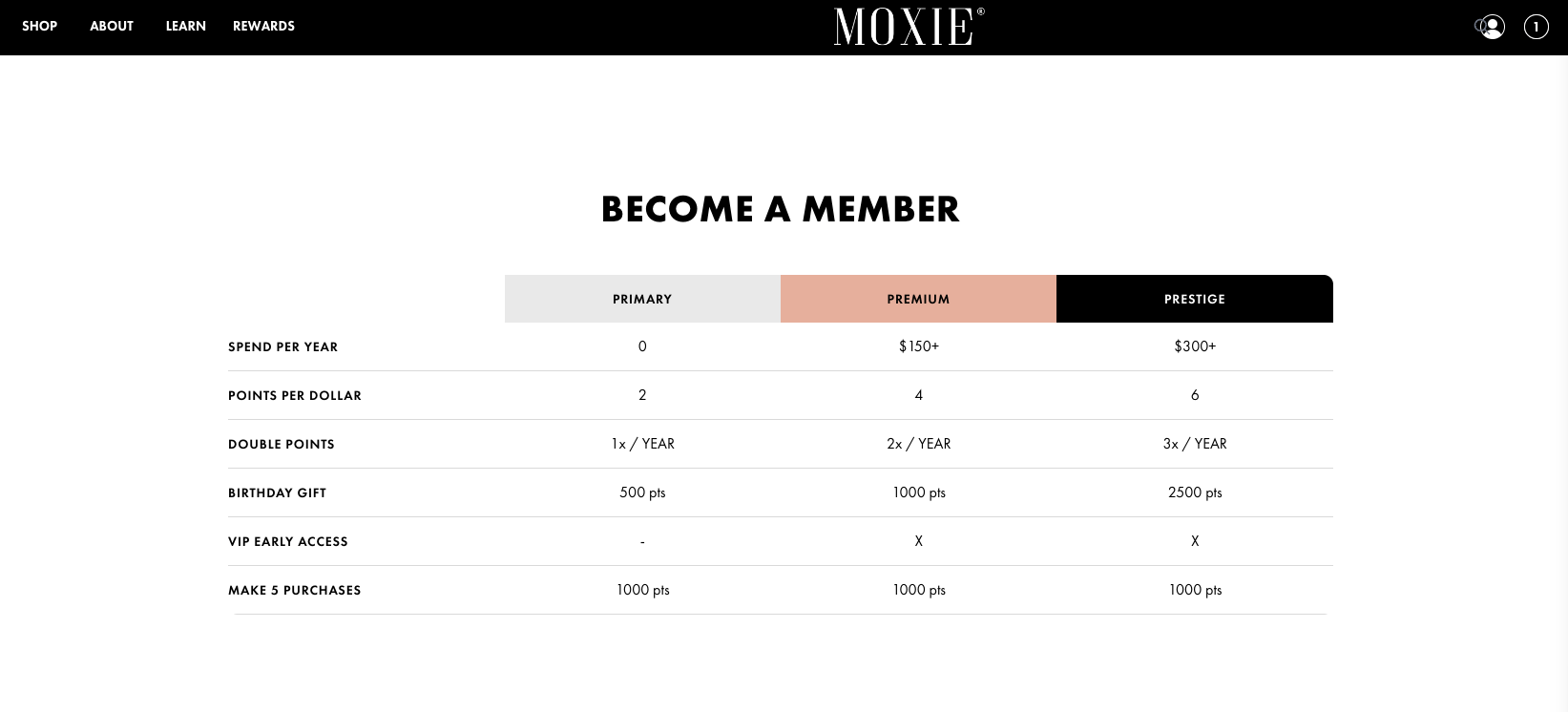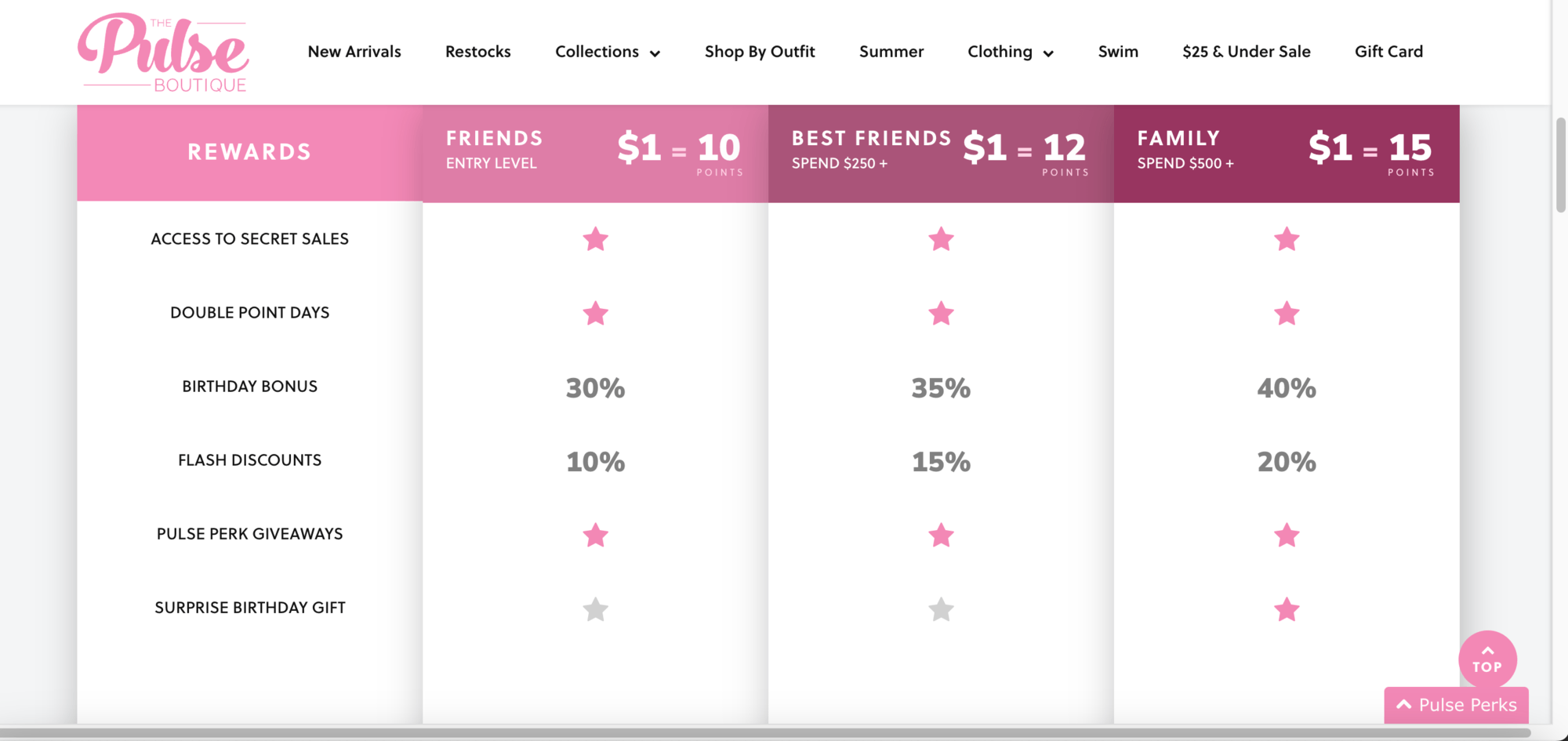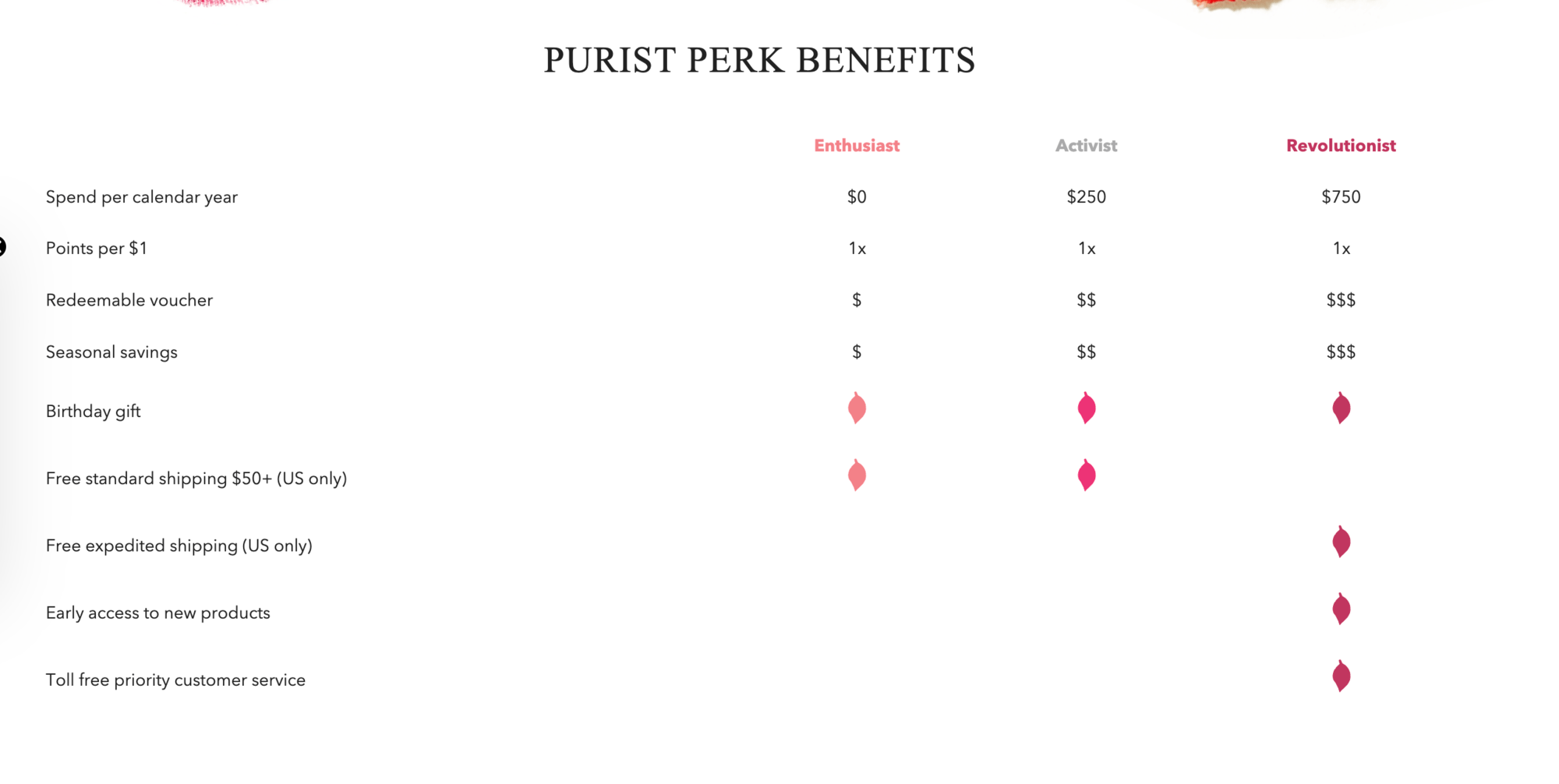A tiered loyalty program is a customer rewards system where members unlock better benefits as they reach higher spending or engagement levels. Each tier offers increasing incentives, encouraging long-term loyalty and repeat purchases.
How does it work? Picture this: a customer, maybe a friend of yours, is shopping online. They might Google something like “magnetic lashes” and see some offers on sites like Amazon or Temu. Maybe they’ve been burned in the past, so they decide to keep looking and find a lash specialist store like MoxieLash.
After browsing the site, your friend also notices that this MoxieLash store has a loyalty program — and that they’d get good perks if they bought directly from the brand instead of through a retailer like Amazon.
“If I’m going to buy it anyway, why not get rewarded for it?” Right?
A few weeks down the line, your friend has built up her spending with the store and realizes she’s close to earning better perks by moving up a loyalty tier. So, they keep buying lashes directly from the brand; after all, they’ve been good products so far.
A few months later, your friend is telling anyone they know who wears lashes to get them from MoxieLash (while your friend loves the brand, they also get extra rewards for referring friends).
While this scenario sounds quite specific, it’s actually more common than you think — Antavo’s 2022 Global Customer Loyalty Report found that organizations with a tiered loyalty program reported a 1.8x higher return on investment than those without tiers. Or, in other words, tiered loyalty programs can be 80% more effective than those without tiers.
So, in this guide, we’re going to run through everything you need to know about creating a tiered loyalty program for your Shopify store, including:
- What is a tiered loyalty program (compared to others)
- Benefits and drawbacks of tiered loyalty programs
- Structuring and designing a tiered loyalty program
- Integrating a tiered loyalty program
- Measuring the success of your tiered loyalty program
- Examples of inspiring tiered loyalty programs
What is a tiered loyalty program (and how does it compare to other types)
A tier-based loyalty program is a system a business uses to reward loyal customers and incentivize long-term engagement with the brand.
The loyalty tiers are predetermined thresholds the business defines in which the more a customer engages with or purchases from the brand, the better perks and rewards the customer gets by moving into a higher loyalty tier.
Tiered loyalty programs are quite different from other types of loyalty programs because of their accumulative structure. For example, here are some other types of programs that businesses commonly use:
Simple points-based program: which involves you spending money or completing activities to earn points, then you can spend your points on rewards. A tiered loyalty program is an evolution of this type of program.
Referral program: where you earn points or fixed discounts towards your next purchase for referring a friend. Similarly to a regular points-based program, you can then use points for rewards if the program uses a points system. You can also have a referral program built into any points-based system, including tiered loyalty programs.
Subscription loyalty program: where you gain more loyalty points and perks the longer you stick with a product subscription. Technically, you can combine subscription loyalty with a tiered system (e.g., having a dedicated subscriber-only tier), but both are effective on their own.
As you can see, a tiered loyalty program is a great method for including multiple loyalty strategies within a single program — but it’s not all sunshine and rainbows.
Benefits and drawbacks of tiered loyalty programs
Tiered loyalty programs are great systems to incorporate into your Shopify store; if not, we wouldn’t be shouting about them from our figurative rooftops. However, there are both benefits and drawbacks you should take into consideration when you’re thinking of building a tiered loyalty program.
Benefits of a tiered loyalty program
Employs gamification to encourage customer engagement. Plenty of research, including from the Journal of Computers in Human Behaviour and the Journal of Electronic Commerce Research, suggests gamification has a positive effect on engagement, brand love, and loyalty.
Customers tend to feel more valued and part of a community. When you grant loyal customers access to higher-value rewards, it makes sense that customers with this level of access would feel more valued. Additionally, if your brand is large enough to have a brand community, loyalty tiers can help members of the community identify each other and engage with and beyond the brand.
It helps you offer experiential rewards. While offering discounts in exchange for points isn’t a bad approach, it doesn’t help your profit margins and can become unsustainable in the long run. Building a tiered rewards structure can help you introduce experiential rewards as exclusive benefits that have minimal impact on your profit margins.
It also helps with your marketing segmentation. It’s not a huge benefit, but it’s a helpful bonus that you can segment your marketing communications to members of specific tiers, which is even more helpful considering the 2024 email compliance changes.
Drawbacks of a tiered loyalty program
Risk of excluding customers if the gap between tiers is too big. You want to make your highest-value loyalty tiers challenging but still attainable for anyone to achieve. As well as making the highest value tier meaningful compared to the bottom tier.
You need to regularly review rewards against market trends. If you offer a variety of loyalty rewards across tiers, you’ll need to keep an eye on competitors who may offer similar rewards to make sure your brand stays competitive.
Without the right tools, loyalty programs can be difficult and costly to maintain. Certainly, developing a loyalty program from scratch would take a lot of time and money before even launching it. But with a tool like LoyaltyLion, you can build and launch a tiered loyalty program quickly, with a higher likelihood of positive ROI.
Structuring and designing a tiered loyalty program
Now that we’ve gone over some of the theory behind tiered loyalty programs, let’s get into the practical elements of building them.
Choosing your program rewards
There are plenty of methods you can choose for customers to earn rewards (e.g., purchasing products, following your brand on social media, referring friends, adding reviews, etc.), but what about the reward itself?
In a tiered loyalty program, it’s a good idea to mix transactional and experiential rewards but add higher-value experiences in the top tiers to help maximize signups and also preserve profitability.
For example, Astrid and Miyu offer mostly transactional rewards at their lowest tier (£10 voucher per 1000 points and a £5 discount on birthdays), as well as bonus point events.
But in their highest tier, they include a first look at new products, early access to sales and promotions, and a free birthday treat.

Naming your loyalty program and tiers
If you’re anything like me, you might find naming your loyalty program challenging. But from looking at lots of loyalty programs in my time, you can’t go wrong with including your brand name in it; here are a few examples:
- Astrid & You (Astrid and Miyu)
- Pulse Perks (The Pulse Boutique)
- Yak Tokens (Lucy & Yak)
- Ofra Beauty Bonuses (Ofra Cosmetics)
However, you might also find good loyalty program name ideas by looking at your brand’s mission or vision statement. For example, Free Fly, an outdoor apparel brand that values simplicity, comfort, community, and freedom, named their loyalty program Freedom Finders.
If you’re still struggling, you can also try writing down a few ideas and conducting a survey among your customers about which idea they prefer the sound of — or you can even create a challenge for your customers to name the program themselves (with acceptable language).
Launching your tiered loyalty program
Before launching your program, you’ll want to tease all the hard work you’ve put into it—share snippets of your program design and the program name on social media and in your email list.
After gaining some attention and building anticipation, launch your program in a time slot just before your store gets a lot of traffic. If you’re not sure when would be the best day and time, analyze your store’s web traffic data and look for regular spikes in traffic to predict the next ones.
Launching your program just before regular traffic will help you avoid overloading your site and crashing it. Once you’ve launched it, remember to go back to your social media, email list, and paid channels (if applicable) to promote the launch.
Integrating a tiered loyalty program
While choosing a provider for building and hosting your tiered loyalty program, there’s one factor you must consider — how well it integrates with your existing system.
Integrating your loyalty program with your ecommerce software
In the vast majority of cases, a loyalty program provider will have an integration with Shopify, given that it’s the biggest ecommerce platform around. So, the differentiating factor here is how easy it is to plug in and go.
You’ll want to make sure that you can build your loyalty program with ease and not get stuck at the final hurdle trying to get it working in your store. With LoyaltyLion, for example, you can integrate your program with Shopify in just a few clicks.
Integrating your loyalty program with marketing tools
The other aspect you’ll need to consider is your other marketing tools — does your choice of loyalty program provider offer integrations with your email marketing tool, reviews tool, helpdesk, subscription provider, and more?
Your loyalty program can help boost the effectiveness of your existing marketing strategies, so why not combine them?
Measuring the success of your tiered loyalty program
As you build your loyalty program, it’s crucial to think about what you want it to achieve — the clearer your goals and objectives are from the start, the more likely you are to make progress.
For example, when building their program, The Pulse Boutique (which we’ll look at in detail shortly) wanted to encourage engagement with the brand on social media and increase the amount of user-generated content on their website.
To help them achieve those goals, they created rewards specifically encouraging this behavior — points for social media follows and significant points rewards for adding reviews, especially those with photos.
Measuring the success of these goals would include monitoring metrics such as earned rewards purchases and repeat purchase rates (which tells the brand that customers are building up enough points with engagement activities and using them for rewards).
In other words, what metrics you measure for your loyalty program should directly correlate with the goals you set out for it to achieve. However, some common success metrics to monitor include revenue from loyalty, customer lifetime value, revenue by initiative, average order value, time between purchases, and repeat purchase rate.
Examples of inspiring tiered loyalty programs
Now that you’ve got all the background knowledge you need, let’s examine some examples of tiered loyalty programs that prove how effective and successful this approach can be.
MoxieLash
I mentioned this brand in the introduction, which was no coincidence. MoxieLash launched in 2017 and generated a lot of buzz, but was struggling with increasing customer acquisition costs. So, they decided to build a loyalty program to help retain existing customers and drive loyal behavior.
The program itself is called MoxieLash Insider, and it has three tiers: Primary, Premium, and Prestige.

The rewards are simple, and the tiers are based on a minimum spending threshold. However, a significant factor of their success was integrating loyalty and email with the Klaviyo integration and an email sequence that helped trigger loyalty activity completion.
Within 12 months of working with LoyaltyLion, MoxieLash saw:
- A 3x increase in loyalty program members returning for a second purchase;
- 2.75x more spending from members per year compared to non-members;
- 50% higher average number of orders from members compared to non-members; and
- 50% higher average spend from members compared to non-members.
The Pulse Boutique
I also mentioned The Pulse Boutique earlier in this guide, and for good reason. The Pulse Perks program is equally as simple as MoxieLash’s, with a mix of transactional and experiential rewards using the three tiers approach:

I mentioned before that the goals The Pulse Boutique set for the Pulse Perks program were to encourage social media engagement and increase user-generated content on their website — both of which serve an overarching business goal of increasing brand awareness and building social proof.
Since launching its program, it has delivered a 39% uplift in returning customers and a 19% increase in average order value, and it has driven over $200k in earned rewards purchases to date.
100% Pure
What if you want your brand to expand and open physical stores but are unsure how a tiered loyalty program would cope? Well, 100% Pure is a store with 12 physical locations, and it uses Shopify Plus and Shopify POS to do this.
With LoyaltyLion’s Shopify integrations, their loyalty program not only coped but thrived in 100% Pure’s omnichannel environment.
The program itself is called Purist Perks and also has three tiers named Enthusiast, Acvitist, and Revolutionist, based on the brand’s mission and values:

As you can see from the image above, the Purist Perks program has more rewards, with a good gap in reward values between tiers.
To date, the Purist Perks program has helped 100% Pure see a 4x reduction in customer churn and a 3x increase in purchase frequency. The program members also spend 72% more compared to non-members, and as a whole, it has driven over $244k in additional revenue.
Build your tiered loyalty program with LoyaltyLion today
To summarize everything we’ve covered today:
Tiered loyalty programs offer a range of benefits, including increased engagement rates, brand loyalty, and other metrics such as average order value, repeat purchase rates, and revenue. However, you’ll need to consider the drawbacks such as the risk of excluding or alienating some customers, the need to regularly review market trends, as well as the potential cost of building the program.
But building the program itself doesn’t need to be hard—with the knowledge you’re now armed with and the right tools in place, you can achieve similar results to the brands we highlighted above.
If you’re ready to elevate your customers’ experiences with a tiered loyalty program, check out LoyaltyLion’s pricing page to find a plan that suits your Shopify store.





